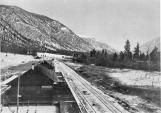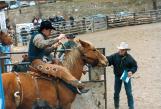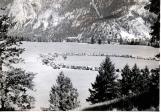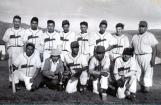48
Across the valley from Chopaka1930's to 1940's
Hwy 3 south of Cawston
 Credits:
Credits:Ann Briley Collection, Okanagan Museum Historical Society
49
The old Train Station at the Chopaka-Washington Border on Chopaka Indian Reserve1906-1930
Chopaka BC Canada
 Credits:
Credits:Ann Briley Collection, Okanagan County Historical Museum
50
Recreation and AthleticsChopaka Easter Rodeo
The Chopaka Easter Rodeo started out as an Easter Sunday family day and picnic. The community would gather to watch baseball after church. Later, the young men would try out stock at the Allison Ranch. Years after the day became a formalized jackpot rodeo. The rodeo continues to be an annual event put on by the Chopaka Rodeo Committee.
The Chopaka Easter Rodeo has been the starting ground of many successful rodeo competitors and participants. Local Native people have been involved in rough stock categories such as saddle bronc, bull riding, bareback to events such as calf roping, team roping, steer wrestling, barrel racing, wild cow milking, calf scramble, pee wee barrel racing.
Chopaka was also the home of the Junior High School Rodeo for many years. The rodeo was organized by Archie and Joyce Jack of Penticton.
Similkameen Rodeo Club
The Similkameen community has long been a ranching and farming community. There has been much involvement in the Old Paul Rodeo that occurred at Blind Creek behind what is now the baseball diamond.
May Day Rodeo
Representation many of the local men and women participated in the Elks Rodeo held in May in Keremeos. There have been a number of young local Native women that have been crowned Royalty representing the Elks Rodeo in the Rodeo Circuit.
52
Team Roping at Chopaka Jackpot Rodeo1999
Chopaka Rodeo Grounds, Chopaka BC, Canada
 Credits:
Credits:Nancy Allison
53
Saddle Bronc at the Chopaka Jackpot Rodeo1999
Chopaka Rodeo Grounds, Chopaka BC, Canada
 Credits:
Credits:Nancy Allison
54
Grand Entry at the Opening of the Chopaka Jackpot Rodeo1999
Chopaka Rodeo Grounds, Chopaka BC, Canada
 Credits:
Credits:Nancy Allison
56
BaseballBaseball has long been a sport of the Similkameen People. The sport started in the fields and in the sage brush in the community where the young people would play scrimmage games amongst one another.
Later the teams were managed and run by the coach who carried the team from reserve to reserve throughout the Okanagan and Thompson areas. The Similkameen team was known for its skill in the game.
The most notable players were Jim Terbasket (pitcher) and James Squakin (Back Catcher). This pair was scouted by the big leagues to play professional baseball but did not follow through to enter the leagues.
Over the years, the teams have joined in the local recreation leagues and many players from both the native and the local off reserve communities continue to play all forms of baseball and softball.
58
BasketballThe Similkameen Community is well known for its skill and enjoyment of basketball. Having never had facilities of its own, the community is renowned throughout the British Columbia Native Amateur Athletic Community as being fierce competitors in the game. There have always been women's teams, men's teams and co-ed teams.
The best known player to come from the Similkameen Native Community was Rainbow Edward whose talent led the Similkameen Secondary School to BC Championship. Rainbow Edward was known throughout British Columbia for his abilities and skills on the court.
School Sports
The indigenous people in the Similkameen valley have a reputation for being excelling athletes. Their contributions made to local sport sucesses have been realized over many generations. Many local school sports records were broken by Male and Female athletes in team sports and in track and field events. Thier contributions continue to play a valuable part in the school athletics and competiton.
59
Cultural RevitalizationCanoe Building
The Similkameen people commenced building of canoes after not doing so for 100 years. At the urging of Okanagan elder Louise Gabriel who envisioned a way of re-connecting the people to waterways and reconnecting the communities to each other, the Okanagan Nation communities came together to build the first dug out canoes. Since the canoes were built, many families have dedicated time and effort to the skill and the knowledge.
In appreciation for bringing forth the knowledge, recognition goes to Gordon Marchand of the Okangan Indian Band. Gordon was trained by his elders to wait for a time when the people would once again need the knowledge to carry on the tradition of canoe building. Locally, Herman Edward has acquired the expertise to continue guiding new learners to carry on the work.
Similkameen Pow Wow
The Similkameen Pow Wow was first held on Labour Day weekend. The event was changed to coincide with the May Day Long Weekend Celebration in order to draw more participation and spectators.
The Pow Wow is a competitive event that is Social in nature. Though not a part of Similkameen Tradition, pow wows provide a venue for traditional people to engage in Dance and Singing. The particpants compete to win monetary prizes. The pow wow became renowned for its rich and colorful entertainment provided to all people, native and non native alike. People enjoyed the beauty and the skill of participants in song and dance.
The cost of the event became a factor in the pow wow becoming discontinued.
61
SocializationPrior to settlement, marriages were arranged between families and between communities. If a man was wealthy, a good provider and could esure that the women were taken care of, he was afforded the respect of taking on more than one wife. Often times, this was done by Higher Chiefs within the societies. This set up the inter-nation relationships and ensured that there was good repoire beween communities and between tribes.
The trading or taking on of wives within the societies would occur during inter tribal encampments. At this time, there would be demonstrations of abilities and skill through gaming and competition. The communities would come together to socialize in the true sense of the world. At this time, there would be no weapons or guard against one another.
Within the common community, parents would discuss the future of their children as husband and wife. Throughout the young peoples lives, the families would exchange gifts between families to maintain the agreement of the arrangement. The practice of arranged marriages ceased in the 1930's. As marriages were no longer arranged, courtship would occur at Social Gatherings between communities. Marriage became the decision of individuals.
If men were abusive to their wives, sisters or mothers, the man was disciplined by the wise men of the community. Women were disciplined if they brought their husband's name or his character in disrepute. The wise men would also deal with the women.
Upon settlement, many of the newcomers took up companions from the native communities. This established a long term relationship with the community to ensure survival but also provided newcomers access to the lands within the traditional territory. Once settlers had established themselves in the area, the Native women and the children were returned to the community. The settlers would bring in new wives from european countries to join them in this country.
After the invasion and attack by the Spaniards in the Similkameen Valley, it was decided within the community that the Similkameen people would not engage in relationships or marriage with Spaniards
.
There were a number of ceremonial practices that occurred over the duration of life. These included ceremonies for birth, rights of passage, name giving, vision quests, sundance, marriages, appointments of leaders, social protocols, warring, deaths etc.



